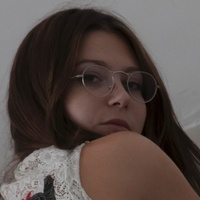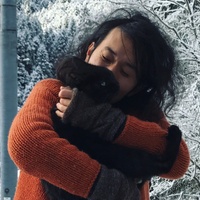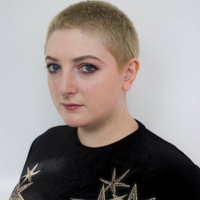As told to Janique Vigier, 2135 words.
Tags: Writing, Collaboration, Inspiration, Process, Creative anxiety.
On experimenting with togetherness
Writer Fiona Alison Duncan discusses the path that led her to being a writer, the usefulness of working with a persona, and the lessons learned from organizing a long-running reading series.Your first novel, Exquisite Mariposa, is coming out this fall. Who is the book addressed to? Or who will it be dedicated to?
I think it’s going to be dedicated to my cat, Noo. I thought I lost my cat this summer, and when I was bawling on the phone to my dad about it, he said, “Yes, I know that cat has been like your family out there in LA.” She was my person while I was writing the book. But also, it’s safer to pick a cat than a human. It’s unlikely Noo knows I dedicated the book to her, though I’ve told her. And I could never pick one human. Even if there was one, for this project, I wouldn’t feel comfortable having that be public.
For my acknowledgements page, I thought about setting it up like a credits line where there’s a cast, producers, editors (the book’s in part about TV and film), but even that involves weighing things in a particular way. Instead, I think I’m going to write out all of the relevant names and lay them out alphabetically, which is usually what I do for [my literary series] “Hard to Read.” First names only, a nice grid. That way I can put lots of people, so many exchanges, and it will be cool to see it laid out like that.
It’ll also become a guessing game.
Yes! I should say—she [Noo] is a pivot point in the book. The dedication might be like, “To Noo, who rescued who?” which is a cheesy bumper sticker they sell at the pet store. It’s a cliché, but I think it’s funny.
I just finished the Janet Malcolm book Two Lives, on Gertrude [Stein] and Alice [Toklas], and there’s a long passage where Gertrude describes feeling ashamed, uncertain, and afraid as a writer, until “someone came along and said yes to it”—affirming what she was liking, doing, and making. Who said “yes” to you?
In terms of this book in particular, there were two people, Asher Penn and Alexa Karolinski, who read early drafts. Or not even early drafts, but first chapters, before I knew they were chapters. Alexa and Asher both encouraged me directly to continue. But there were others, the filmmaker John Walter, a confidante. He once said, “You belong to art.” And [my friend] Amalia, who pushed me to go further with one character, which I knew I needed to do, but I was being avoidant. I was afraid.
I feel like a novice at the Oscars, wanting to list a thousand names and getting cut off by music. It’s tricky, this stuff, because I’ve realized, in the process of writing this book actually, that what I looked for before were really obvious modes of encouragement, unsubtle ones, like “you should do this”; “you’re the chosen one”; “we need you”–which my boyfriend now does constantly.
Do you think of yourself as having a persona? How do you operate with it?
Maybe, probably. I was a bit older than most of the characters in the household, in the book. I didn’t have that same integrated online persona as them. A lot of the girls, the characters in the book, were more conscious than I was about the construction of persona as a means to get or communicate something, and were in many ways more eloquent in their performance, and capable of separating themselves, whereas it was more sticky and enmeshed for me, tied to some idea of authenticity, naive. Personas had been, for me, wish fulfillment—what I wished I could be, ego, or a social habit I felt I needed to have in order to survive. At some point I wanted to unstick from all of that. I tried. There was a phase when I wasn’t on the internet at all. I didn’t look at mirrors. I disappeared for a while. I was alone, but out in the world, just walking a lot. I like “Hard to Read” as a persona. It satisfies my desire to be out there but also to be private, secret, and subservient—or just have the feeling, maybe it’s illusive, thereof.
“Hard to Read,” your literary series, is highly communal, where writing’s often isolating. What are the differences between organizer Fiona and writer Fiona?
One of the initial premises for the book was wanting to do something collaborative among a group of young people, but I don’t feel that we knew how to treat each other as equals. There was the hierarchy of the people who wanted to pay us to do this, who were simultaneously looking down on us and thinking they could control us, while wanting to put us up in the spotlight or up on this pedestal. I knew there was something off about this, but I didn’t know how to articulate it.
“Hard to Read” was an early way to experiment with togetherness. With a group reading, you have a mix of people who never write, people who write professionally, and then me, who was a super awkward host. My voice would crack at first. Sometimes I would ask people I looked up to to be involved, sometimes I felt more maternal, nurturing someone through it. Other times someone was a star and would take over the show and I would just have to watch. There were all sorts of dynamics happening, and doing that 1-3 times a month changed me a lot, and made me more responsible, mostly.
The goal was always trying to figure out how you can work with people in a real way, because that’s something I was craving and lacking. I think that so many people in my demographic want that. It’s a political weakness for us perhaps, the cult of personality and individuality, competition, alienation, exhausting in-fighting amongst potential allies. My demographic being femme, queer, and allied, young, Millennial (I guess), artistic, and not just American. I have friends with all kinds of passports, but in or informed by America. I’ve been here for seven years.
Did you have models for what you want to achieve with “Hard to Read” and “Pillow Talk?”
There were counter-models in the case of “Hard to Read.” Most readings are needlessly boring. I was also jealous of art openings. I wanted writing to have a glamorous equivalent. For “Pillow Talk”—and I’ve written about this a bit already—the models for my reading series were feminist-consciousness-raising circles, or my ideas thereof, having only read about them; anonymous recovery programs; childhood sleepovers; community sex parties; and Kundalini or meditation classes, when they’re good. And again, counter models: not academia or school, not the internet. I needed realness, presence, and the potential for fun even when the topics are heavy.
Why a concentration on reading, rather than writing?
I wanted a new medium and venue to communicate through—with more or a different kind of attention given to writing. With an audience you can see, you get some energetic feedback. I might’ve been an actress, or at least a gymnast, if I’d been raised around more performers. Instead, I was raised around readers, introverts, and nerds. Criticality, intellectual rigor, even literariness—that’s not where my heart swoons. But it’s been programmed into me, into my head. I wish I wasn’t a writer. “Too late,” everyone replies. I think both “Pillow Talk” and “Hard to Read” seek to reunite a broken heart and spirit with this brutalizing brain.
What did you read as a teenager?
Not much. I wasn’t really motivated to read except to impress or connect with people: crushes, teachers. I did read chick lit and erotica during summer as if it were contraband, and always fashion magazines. The French ones were my favorite. I knew all the models’ names by heart. They all looked the same back then. This was the post-supermodel, pre-Kardashian phase of famous model. They were all teenage, European or Brazilian, with proportions like my favorite palm trees—those anti-gravity ones that sway dangerously in the wind. I only started reading as an escape from reality and to understand it—obsessively—when I moved to New York.
You recently moved back to New York after four years away. How has your relationship to the city changed since those days?
There’s a Fanny Howe quote: “Growing old is growing wild. Growing mad is growing old too fast.” I went crazy, derealized and depersonalized here. The month I left, I had four panic attacks. I’d been poisoned with carbon monoxide in an “artist’s loft” I was living in. I was actually excited by the prospect that my brain, after months of exposure to the gas, might have irreparable damage. Maybe I can become a painter, I thought, and I won’t ever have to think to write again. The week before my housemates and I all passed out from the gas leak (it amped up in winter), I’d learned that model Karlie Kloss got a day rate of 30K, and that she was dating and soon to marry Joshua Kushner, whose brother is married to Ivanka Trump, and whose father’s estate dealings I was now reading up on, since coming to better understand my expendable role in gentrification. I needed to understand more.
That was in 2015. I moved to New York in 2012, I didn’t know why, which is probably why it was so gnarly. It’s a crazy city to try and float in; I felt kicked around instead. I started reading a lot, as I said, because I needed to catch up. I was sheltered and naive or ignorant when I first came here. Or maybe just very Canadian. I learned too much too fast, and went mad. It was good to leave, and to process it all. LA flattered my flightiness, but I don’t like long distance. I’m back in New York for a relationship. I wouldn’t be here if it weren’t for him. But it’s good, beyond him. I like the dogs and delis uptown, and I’m learning new things again.
What responsibilities do writers have?
I’ve heard writers say: “None.” Or, “Artists should just be free to express themselves.” I’ve heard that even more from contemporary visual artists who work with narrative and character: “It’s just art,” or, “It’s just a mirror to reality. I’m not responsible.” I might feel that way if I could get away with it, but I don’t feel I could be so isolated, or so self-sufficient. Writing is ethically very treacherous. I want my subjects and readers to feel respected, appreciated, and—best as I can—understood or liberated. The internet has made writing very interactive. I don’t write anything without thinking about its potential impact, of it as a conversation and process, as part of the world, with consequential potential. What do you think? I’m very interested in this question actually, maybe it should be a “Hard to Read” panel.
Did you read your book out loud as you were writing it?
Yes, of course. Everything I write I mumble-read to myself over and over, and if I’m really alone, which is unfortunately rare, I read it properly aloud.
What’s your greatest pleasure?
Oh, I can’t. There are too many. What’s coming to mind—as most wanted now, elusive so it seems great—is the peaceful pleasure of being mindfully unselfconscious, present to what’s happening but fully engaged with it, in time with it. Often in social situations I feel like I’m working in a two- to 20-second delay, sometimes it’s a two-day or two-year delay. Alone, my processing is on time, my time. What I have a hard time with is keeping up with group convos, when information, hot takes, stories, and replies bound around a table. That’s when I feel stupidest, and most fearful maybe. When somehow, I manage to feel confident, trusting, and mutually cared for enough in a group situation to really let go and be myself, to speak fluidly—that feels so good. It shouldn’t be rare. Is it for you?
Fiona Duncan recommends:
-
Color Me Flo: My Hard Life and Good Times. A collection of memoir and essays by activist and attorney Florynce Kennedy, illustrated with pics of her many great outfits.
-
Jeffrey Stark gallery. (Bias: my show just closed there, but I’ve long admired the space and programming)
-
Chakrubs crystal sex toys. Sit on ‘em and meditate.
-
Telfar F/W’19-20, a collection called “Country” with a burnt-out American flag as its promo photo and Tzitzit-like embellishments.
-
Considering this quote in your relationships and habits (reading, spending, otherwise): “Attention is the sincerest form of generosity.” — Simone Weil




